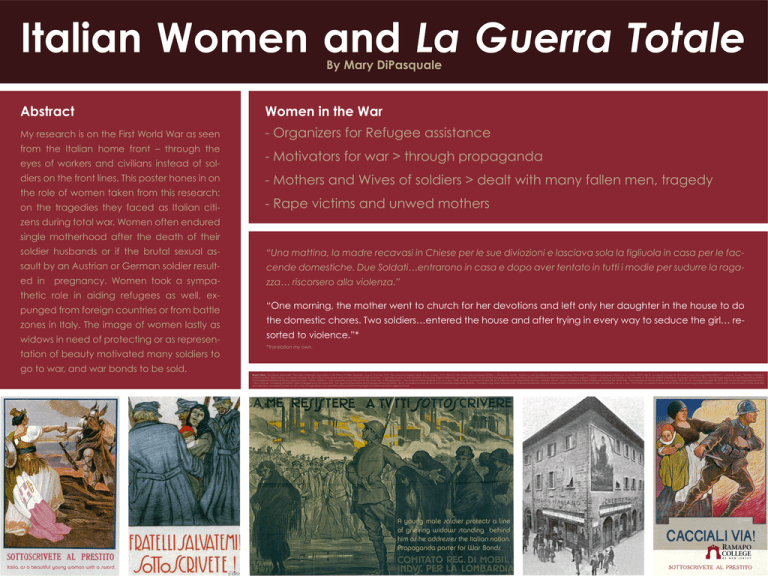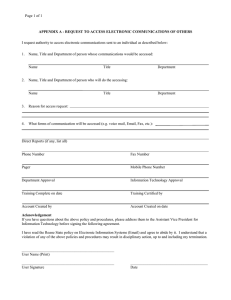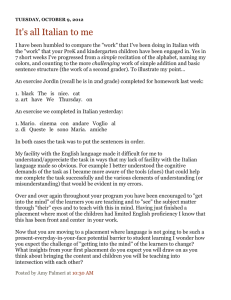
Italian Women and La Guerra Totale
By Mary DiPasquale
Abstract
Women in the War
My research is on the First World War as seen
- Organizers for Refugee assistance
from the Italian home front – through the
eyes of workers and civilians instead of soldiers on the front lines. This poster hones in on
the role of women taken from this research:
on the tragedies they faced as Italian citi-
- Motivators for war > through propaganda
- Mothers and Wives of soldiers > dealt with many fallen men, tragedy
- Rape victims and unwed mothers
zens during total war. Women often endured
single motherhood after the death of their
soldier husbands or if the brutal sexual as-
“Una mattina, la madre recavasi in Chiese per le sue diviozioni e lasciava sola la figliuola in casa per le fac-
sault by an Austrian or German soldier result-
cende domestiche. Due Soldati…entrarono in casa e dopo aver tentato in tutti i modie per sudurre la raga-
ed in pregnancy. Women took a sympa-
zza… riscorsero alla violenza.”
thetic role in aiding refugees as well, expunged from foreign countries or from battle
zones in Italy. The image of women lastly as
widows in need of protecting or as representation of beauty motivated many soldiers to
go to war, and war bonds to be sold.
“One morning, the mother went to church for her devotions and left only her daughter in the house to do
the domestic chores. Two soldiers…entered the house and after trying in every way to seduce the girl… resorted to violence.”*
*Translation my own.
Works Cited —De Grand, Alexander. “The Italian Nationalist Association in the Period of Italian Neutrality, August 1914-May 1915.” The Journal of Modern History 43, no. 3 (Sept. 1971): 394-412. http://www.jstor.org/stable/1878561. —Ermacora, Matteo “Assistance and Surveillance: War Refugees in Italy, 1914-1918.” Contemporary European History 16, no. 4 (Nov. 2007): 445-59. Accessed October 28, 2014.http://www.jstor.org/stable/20081377. —Grayzel, Susan. “Women at Home in
a World at War.” British Library. Accessed October 24, 2014. http://www.bl.uk/world-war-one/articles/women-at-home. —I figli della Guerra, in the University of Wisconsin Digital Collections, accessed October 24, 2014,http://images.library.wisc.edu/History/EFacs/WWIArchives/AgliAmici/reference/history.agliamici.i3.pdf. —Il Saluto d'una Madre, in the University of Wisconsin Digital Collections, accessed October 24, 2014, http://images.library.wisc.edu/History/EFacs/WWIArchives/AgliAmici/reference/history.agliamici.i7.pdf. —Renzi, William A. “Italy's Neutrality and Entrance Into the Great War: A Re-Examination.” The American Historical Review 73, no. 5 (jun. 1968): 1414-32. Accessed October 28, 2014. http://www.jstor.org/stable/1851376. —Roberts, David. “Croce and Beyond: Italian Intellectuals and the First World War.” The International History Review 3, no. 2 (Apr. 1981): 201-35. Accessed October 28, 2014. http://www.jstor.org/stable/40105125.
—Row, Thomas. “Mobilizing the Nation: Italian Propaganda in the Great War.” The Journal of Decorative and Propaganda Arts 24 (2002): 140-69. Accessed October 28, 2014. http://www.jstor.org/stable/1504186. —Tomassini, Luigi, and Catherine Frost. “Industrial Mobilization and the Labour Market in ItalyDuring the First World War.” Social History 16, no. 1 (Jan. 1991): 59-87. Accessed October 28, 2014.http://www.jstor.org/stable/4285902. —Una Lettera, in the University of Wisconsin Digital Collections, accessed October 24, 2014, http://images.library.wisc.edu/History/EFacs/WWIArchives/AgliAmici/reference/history.agliamici.i9.pdf
A young male soldier protects a line
of grieving widows standing behind
him as he addresses the Italian nation.
Propaganda poster for War Bonds.
Italia, as a beautiful young woman with a sword.





